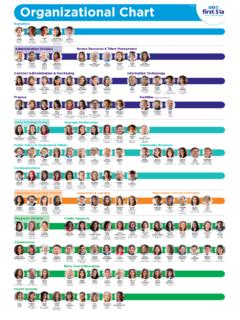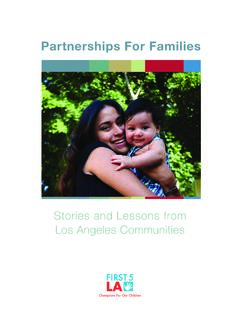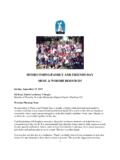Transcription of Families, Friends & Neighbors: Understanding the Needs of ...
1 Families, Friends & Neighbors: Understanding the Needs of FFN Childcare Providers in County May 2012 Executive Summary 4 Introduction 5 Background on family , Friend and neighbor Programs 6 Review of the Literature 6 Models for Supporting family , Friend and neighbor care 7 Background on First 5 LA s Work with FFN 9 Purpose 9 Methodology and Sample 10 Findings 11 Characteristics of Providers 11 Characteristics of Child care 12 Motivation for Providing care 13 Relationship to Parents 13 Challenges 14
2 Resources Needed 14 Limitations 14 Recommendations 15 References 16 Table of ContentsIntroductionFamily, friend and neighbor care is the most common type of non-parental child care in the United States. family , friend and neighbor child care providers are typically a relative, babysitter, friend or neighbor . They are exempt from licensure and are subject to minimal regulation. First 5 LA is a child-advocacy organization that funds the Families, Friends and Neighbors (FFN) Training and Mentoring Project for Child care Providers. First 5 LA makes grants to organizations that offer mentoring and various classes to FFN providers, with the objective of increasing the training and education levels of the license-exempt child care workforce in Los Angeles County.
3 This interaction with FFN providers offers a unique opportunity to learn more about this population and its of the StudyGiven the limited information that exists on family , friend and neighbor providers, this study is an effort to increase the overall knowledge about this population, particularly in County, in a way that can help various stakeholders, including First 5 LA, in future program planning and policy decisions impacting this group. Using provider surveys and focus groups, this study explored the following questions: What are some unique characteristics of FFN providers? What are some distinctive Needs of FFN providers? What are some unique opportunities inherent in the FFN caregivers relationship with their clients? What are the most effective strategies for reaching this population and supporting them in their work?Findings from First 5 LA Grantee AgenciesTo explore our research questions, we used a mixed-methods approach consisting of survey and focus group data.
4 A total of 448 surveys were submitted to First 5 LA between December 2007 to April 2011. First 5 LA Research and Evaluation staff also conducted a total of five focus groups with FFN caregivers at three different First 5 LA FFN agencies. There were a total of 44 participants in our formal focus group discussion. What we learned from the survey and focus groups can be categorized into two major categories: Unique characteristics of FFN providers funded by First 5 LA The great majority (99 percent) of FFN providers are female. They are predominantly Latina (98 percent), and most are fluent in both Spanish and English. Provider ages range from 14 to 71. The majority of providers fall within the range of 30 to 49 years old, with the median age being 37. FFN providers care for anywhere from one to 20 children, and the median provider cares for two children. Distinctive Needs of FFN providers More than 80 percent of FFN providers are interested in becoming licensed.
5 FFN caregivers provide child care primarily because they need the income (42 percent), to help a friend or relative (30 percent) or because they enjoy being with children (19 percent). Thirty-one percent of FFN caregivers say the biggest challenge is that they do not have enough time to themselves, 26 percent say they do not have enough toys or materials and 25 percent said their work hours were long or irregular. RecommendationsFirst 5 LA had three goals for FFN providers, which included enhancing the skills and knowledge of FFN caregivers, increasing caregiver social connectedness with other providers and enhancing provider knowledge and utilization of community resources. Based on the current study findings, several recommendations can be made to further attain these three goals in the future: Offer resources in Spanish Provide resources and education for providers about the licensure process Offer classes and activities in the evenings Link providers to community resources Educate providers and families about childcare subsidies Provide classes in the areas where there is greatest interestExecutive SummaryFirst 5 LA Families, Friends & Neighbors4 Executive SummaryFamily, friend and neighbor care , also described as kith and kin care , home-based care , informal child care , unregulated care and license-exempt care , is the most common type of non-parental child care in the United States (Brandon, 2005; Susman-Stillman & Banghart, 2008).
6 Nearly half of all children with working parents spend time in family , friend and neighbor care . For a majority of these children, family , friend and neighbor care is their only child care arrangement. Although researchers and policymakers have not decided on a consistent term or definition to describe family , friend and neighbor care , it is generally defined as: Home-based care in the caregiver s or child s home provided by caregivers who are relatives, Friends , neighbors, or babysitters/nannies who are unlicensed or subject to minimal if any regulation (Susman-Stillman & Banghart, 2008). In California, a relative is considered a grandparent, aunt or uncle, and caregivers can be exempt from licensing if they care only for relatives, or if they care only for the children of one family beyond their own (Child care Law Center, 2004).In this report, we describe what is known about family , friend and neighbor providers nationwide, the models developed to help support family , friend and neighbor caregivers and how the Families, Friends and Neighbors (FFN)* providers served by First 5 LA are unique.
7 We explore, using provider surveys and focus groups, the distinctive Needs of this group of caregivers in County, the unique opportunities inherent in the FFN caregivers relationship with their clients and what are the most effective strategies for reaching this population and supporting them in their very important work. Introduction*Throughout this report, we refer to the family , Friends and Neighbors initiative by its acronym, FFN When referring to participants in this initiative, we refer to them as FFN providers When referring to the literature on family , friend, and neighbor care providers, the acronym is not used 5 IntroductionReview of the LiteratureFamily, friend and neighbor providers are an important component of the child care workforce, particularly for young , friend and neighbor caregivers make up a significant portion of the child care workforce, representing almost half of all paid caregivers for children under age 5 (Brandon, 2005).
8 In addition, a study conducted by the Human Services Policy Center (HSPC) and the Center for the Child care Workforce (CCW) estimated that there are approximately million family , friend and neighbor providers in the United States caring for children under age 5 (Susman-Stillman & Banghart, 2008). family , friend and neighbor providers are very diverse, demographically and in terms of experience. Because of this diversity, it is difficult to identify their average age of family , friend and neighbor caregivers is mid to late 40s, although their ages range from the late teens to more than 80 years old (Porter & Kearns, 2005b; Porter, Rice, & Mabon, 2003). While the age of family , friend and neighbor caregivers varies, their gender remains fairly consistent. Research indicates the majority of family , friend and neighbor caregivers are female (Drake, Greenspoon, Unti, Fawcett, & Neville-Morgan, 2006). Among family , friend and neighbor caregivers in the Minnesota child care survey, for example, 86 percent were female (Chase, Arnold, Schauben, & Shardlow, 2006).
9 The ethnicity of family , friend and neighbor caregivers often matches the children they care for, even when the caregivers are not relatives. Although all ethnic groups use family , friend and neighbor care , the use of family , friend and neighbor care may be more prevalent among minority groups. It is, however, unclear whether different patterns of utilization are due to preference, or rather to issues of access to other types of care (Susman-Stillman & Banghart, 2008). family , friend and neighbor caregivers vary in their amount of education, child care training and work experience. The educational backgrounds of caregivers, for example, range from less than high school to four year college degrees (Porter & Kearns, 2005b). The First 5 California Informal Child Caregiver Support Project found that, although 40 percent of the caregivers did not graduate from high school, an additional 40 percent reported some college or a college degree (Drake, Unti, Greenspoon, & Fawcett, 2004).
10 However, less than 50 percent of respondents had received CPR training. family , friend and neighbor providers generally care for children to assist a family member or are several different reasons family , friend and neighbor caregivers provide care , but the most common reason is to help a family member or friend (Chase et al. 2006). This is not surprising, considering one of the main characteristics of family , friend and neighbor caregivers is the close relationship they have with the children and families in their care . Many family , friend and neighbor caregivers also say that they provide care because they enjoy caring for children. A small percentage of caregivers, generally nonrelatives, provide care to generate income, and these caregivers are more likely to consider child care a business (Chase et al., 2006; Porter & Kearns, 2005b). family , friend and neighbor caregivers are most often relatives of the children they care for (Susman-Stillman & Banghart, 2008).













